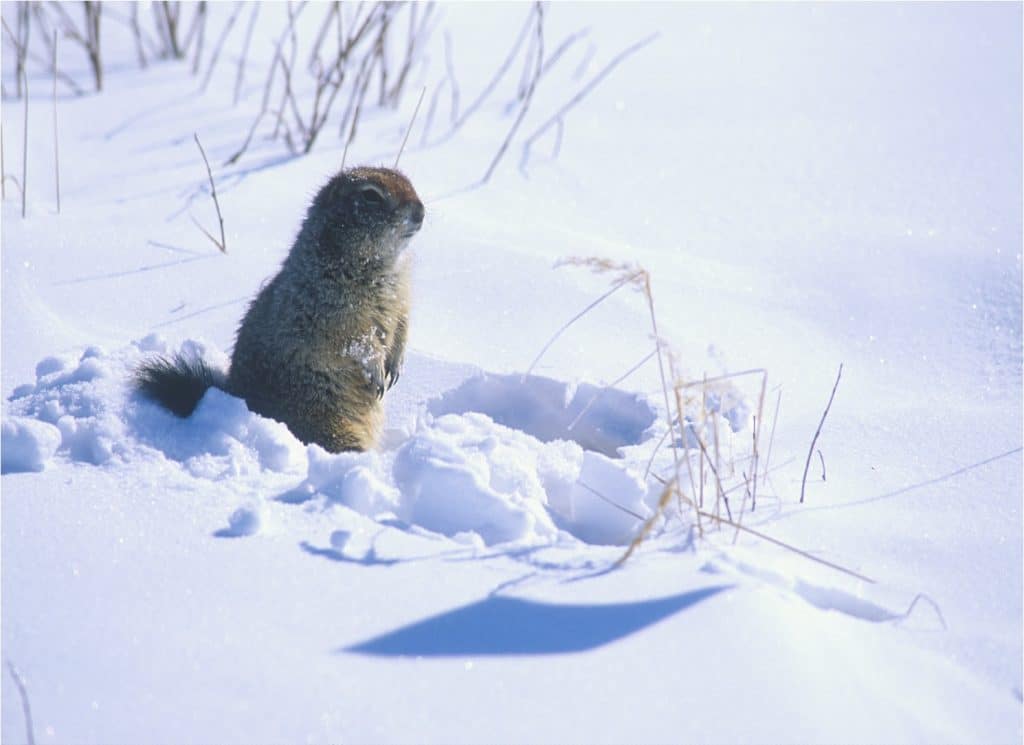Did you know that arctic ground squirrels can keep from freezing even when body temperatures dip below that mark on the thermometer? It’s all about how they hibernate. New research published in Science that analyzes more than 25 years of climate and biological data found that as climate change is warming the Arctic, how these little mammals hibernate is changing, which could be a bellwether for other species.
The research, which NAU biology professor Loren Buck, a contributing author on the study, began in Alaska more than two decades ago, found that the female and male squirrels have developed different hibernation periods over that time. The females “rise and shine” a little earlier in response to warming, which could have both positive and negative ripple effects throughout the food web in these ecosystems.
Senior author Cory Williams, assistant professor in the Department of Biology at Colorado State University, began studying arctic ground squirrels while at the University of Alaska Fairbanks more than 15 years ago. “I think the thing that makes our study unique is that we are looking at a long enough dataset to show the impacts of climate change on a mammal in the Arctic,” Williams said. “We can show a direct link between changes in temperature and the physiology and ecology of these animals.”
Helen Chmura, lead author for this latest research, started the analysis while a postdoctoral fellow at the University of Alaska Fairbanks in 2018 and now works as a USDA Forest Service researcher with the Rocky Mountain Research Station. “Our data show that the active layer, the soil layer above the permafrost, freezes later in the fall, doesn’t get as cold in the middle of winter, and thaws slightly earlier in the spring. These changes, amounting to about a 10-day reduction of the time soil is frozen at a meter deep, have occurred over just 25 years, which is fairly rapid.”
Arctic ground squirrels survive harsh Alaska winters by hibernating for over half the year, drastically slowing their lungs, heart, brain, and body functions. They still must spend energy to generate enough heat from stored fat to keep tissues from freezing. They resurface from their burrows more than three feet below the ground each spring, famished and eager to mate.
The authors analyzed long-term air and soil temperature data at two sites in Arctic Alaska in conjunction with data collected using biologgers. They measured abdominal and/or skin temperature of 199 free-living individual ground squirrels over the same 25-year period. They found that females are changing when they end hibernation, emerging earlier every year, but males are not. Changes in females match earlier spring thaw. The advantage of this phenomenon is that they do not need to use as much stored fat during hibernation and can begin foraging for roots and shoots, berries and seeds sooner in the spring. Scientists think this could lead to healthier litters and higher survival rates.
The downside is that if the males also do not shift hibernation patterns, there eventually could be a mismatch in available “date nights” for the males and females. Ground squirrels also are an important source of food for many predators, such as foxes, wolves and eagles. An indirect consequence of being active above ground longer is greater exposure and risk of being eaten.
What will happen to the population is a big unknown—there are no clear winners or losers. While hibernation requires less energy, which could help overwinter survival, ground squirrel numbers also depend on how predators respond to climate shifts. For now, Williams concludes, “Our paper shows the importance of long-term datasets in understanding how ecosystems are responding to climate change.” Chmura agreed, adding, “It takes a great team to continue a dataset like this for 25 years, especially in the Arctic.”
Buck began this study in the 1990s with Brian Barnes, a professor at the University of Alaska Fairbanks and his Ph.D. advisor, to investigate how arctic ground squirrels survive such long, cold, dark winters and just how cold their hibernation spots were. It expanded to include Williams, who was Buck’s Ph.D. student, and Chmura. Over the length of the study, it has been funded by a variety of sources, including the National Science Foundation, the Department of Defense and the National Institutes of Health.
“What we have here is three ‘generations’ of arctic physiologists working together over the years to compile the data for this long-term study of free-living arctic ground squirrels,” Buck said. “The success of this research projects highlights the importance of continuous and long-term investment in field research and demonstrates the importance of continuity of collaborative teams.”



